Purma
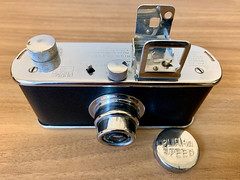
|
| Purma Speed image by Richard Jemmett (Image rights) |
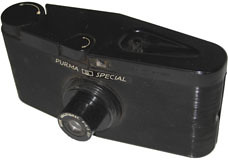
|
| Purma Special, lens out image by AWCam (Image rights) |
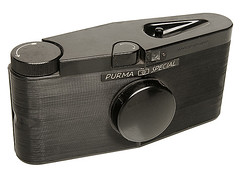
|
| Purma Special, lens cap on image by Rick Soloway (Image rights) |
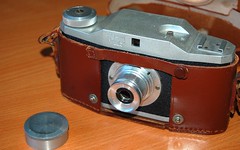
|
| Purma Plus image by Raúl Sá Dantas (Image rights) |

|
| Purma Plus image by Raúl Sá Dantas (Image rights) |
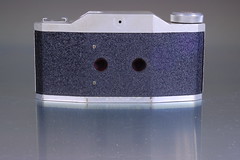
|
| Purma Plus; two red windows image by Raúl Sá Dantas (Image rights) |
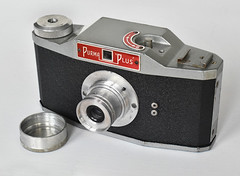
|
| Purma Plus - third version image by Geoff Harrisson (Image rights) |
Tom Purvis, a renowned artist, and Alfred C. Mayo founded Purma Cameras Ltd. in 1935. David Brock of Brock Fireworks gave financial help to launch the company in London. Their office was at Brock House, Langham St, London W1.
The cameras of the Purma brand were 127 roll film viewfinder cameras with innovative gravity controlled shutters, based on the company's patents of 1935 and 1936, designed by founder A.C. Mayo. Purma cameras and accessories were sold by R. F. Hunter of London.
The most common, the Purma Special was made almost entirely of Bakelite, apart from the glass lens, plastic viewfinder optics and shutter & spring mechanisms. Styling was apparently due to Raymond Loewy’s London Office.
There were several interesting features;
- The focal plane is curved, with a solid metal, curved focal-plane shutter with three speeds, controlled by a weight, which varied the slit-width. The shutter is cocked using a pear-shaped lever on the top edge, above the lens; the slit width/shutter speed depends on which way up the camera is held. Horizontal gives medium speed, vertical with winding knob down gives slow, and vertical, knob up, fast. See the Living Image site for photos of the shutter.
- The lens is sprung to telescope out of the body when the screw-on lens cap is removed. Capping (and so collapsing) the lens locks the shutter release - which, unusually, is on the photographer's left.
- the ever-ready case opens upwards from underneath the lens, unlike most cases, which open forward from the back.
- The Purma is said to be the first camera to have plastic optics, although this is in the viewfinder only.
Models
There were three models marketed:
- Purma Speed, introduced 1936; enamelled metal/chrome body
- Purma Special, introduced 1937; all Bakelite body
- Purma Plus, introduced 1951, costing £12-12-0 and lasting until ~1959; aluminium body
Another model, the SAMA, stayed in prototype status despite Purma's 1952 patent on it.
The Purma Speed was a metal-bodied camera with a six-speed shutter, 1/25-1/200 and a flip-up viewfinder[1].
Specifications
- Country of Origin: England[2]
- In production: 1936-1959 (suspended during World War II)
- Shutter: curved focal-plane gravity controlled, 3-speeds, Slow: 1/25, Medium: 1/150, Fast: 1/450 (Special); 1/500 (Plus)
- Lens: Purma Special - Beck Anastigmat, 2¼ inch (~57mm) f/6.3, collapsible
Purma Plus - Purma Anastigmat 55mm f/6.3 collapsible - Film: 127 roll film, sixteen 31mm (1¼inch) square exposures
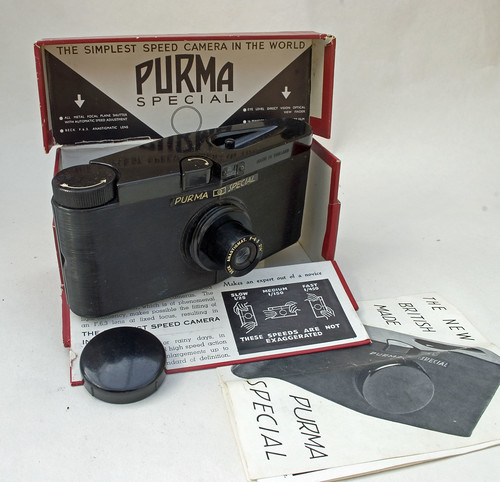
|
| Purma Special and Original Package image by Dave Dockerill (Image rights) |
References
- Coe, Brian, Cameras, From Daguerreotypes to Instant Pictures, pp.129-132, Marshall Cavendish Editions, London, 1978
- Christies, The British Camera 1840-1960 - The Jim Barron Collection, Lot 13, South Kensington 2002
| British companies | ||
| Adams & Co. | Agilux | Aldis | APeM | Aptus | Artima | Barnet Ensign | Beard | Beck | Benetfink | Billcliff | Boots | British Ferrotype | Butcher | Chapman | Cooke | Corfield | Coronet | Dallmeyer | Dekko | De Vere | Dixons | Dollond | Elliott | Gandolfi | Gnome | Griffiths | G. Hare | Houghtons | Houghton-Butcher | Hunter | Ilford | Jackson | Johnson | Kentmere | Kershaw-Soho | Kodak Ltd. | Lancaster | Lejeune and Perken | Lizars | London & Paris Optic & Clock Company | Marion | Marlow | Meagher | MPP | Neville | Newman & Guardia | Pearson and Denham | Perken, Son and Company | Perken, Son & Rayment | Photopia | Purma | Reid & Sigrist | Reynolds and Branson | Ross | Ross Ensign | Sanderson | Sands & Hunter | Shackman | Shew | Soho | Standard Cameras Ltd | Taylor-Hobson | Thornton-Pickard | Underwood | United | Watkins | Watson | Wynne's Infallible | Wray |
Notes
- ↑ 1936 Purma Speed advert on HistoryWorld.com
- ↑ A sales brochure for the Purma Plus has this line:
Purma Plus Cameras are produced in Great Britain by Purma Cameras Limited, Hirwaun Industrial Estate, Rhigos, Aberdare, Glam. (Glamorgan, Wales).
Links
- Purma Special on the Living Image Museum
- Purma on the OneTwoSeven site dedicated to 127 film photography
- Purma Cameras on David Gardner's Great British Cameras site - an extensive article with photos of all three models.
- Purma Special at Scott's Photographica
- 1935 and 1936 patent at Google patent search
- Purma plus, Purma special on www.collection-appareils.fr by Sylvain Halgand (in French)
- Documents at www.orphancameras.com: